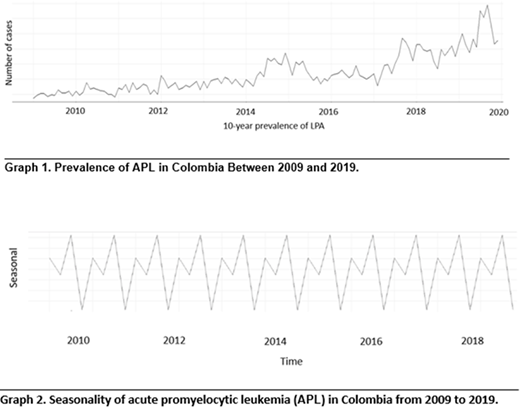Background
Acute promyelocytic leukemia (APL) is a malignant hematologic disease with a high cure rate, but unfortunately it produces several serious complications at the onset of the disease that explain the high early mortality. Based on clinical experience and the papers that precede this document, it has been observed that the incidence of this type of hematological cancer tends to increase at certain times of the year. The present study aims to determine the possible variations in the time intervals of the prevalence of promyelocytic leukemia in Colombia in the decade 2009 to 2019, in order to identify the behavior of the event, seasonality and cyclicality.
Methods
With data from the individual records of service provision (RIPS) of the official Colombian health system, the prevalence of APL in Colombia from 2009 to 2019 was identified. A filter was made by people attended, main diagnosis, C924 - promyelocytic leukemia acute, by year, semester and month. The analysis was performed with RStudio, R version 4.0.2 (2020-06-22); The fpp2 library was used, the analysis of the monthly and quarterly time series was carried out, the decomposition of the time series was carried out, trying through this process to evaluate the seasonal indices through additive and multiplicative types.
Results
During the entire period 2009 to 2019, 2,986 APL diagnoses were found throughout the national territory of Colombia. A progressive increase in prevalence was determined in the period studied (Graph 1). Cycles of increasing cases were observed every 10 months in the period 2009 to 2015 and in the cycle from 2016 to 2019 there was a prolongation of the cycle every 17 months, which strongly suggested that APL has cyclical behavior. Quarterly seasonality was identified by the multiplicative method with increases and decreases that behave in a similar way throughout the period studied (Graph 2).
Conclusion
APL is a highly curable disease that requires adequate support at the onset of the disease to avoid early mortality. The data from this study allow us to conclude that for the period 2009 to 2019 there is a seasonal behavior of this malignant hemopathy. The possibility of predicting during which months of the year the incidence of the disease will increase can serve to properly plan the health services in charge of treating this disease. Additional studies are required to determine what is the cause of the cyclical and seasonal behavior of this APL
Idrobo:Amgen:Honoraria, Speakers Bureau;Takeda:Honoraria, Speakers Bureau;Janssen:Honoraria, Speakers Bureau;Tecnofarma:Honoraria, Speakers Bureau;Abbvie:Honoraria, Speakers Bureau.
Author notes
Asterisk with author names denotes non-ASH members.


This feature is available to Subscribers Only
Sign In or Create an Account Close Modal